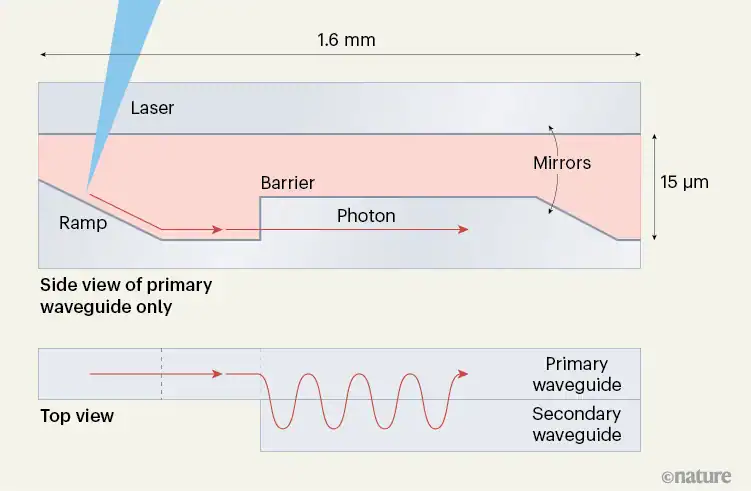
A new experiment that measures the quantum tunnelling of photons between two waveguides has produced results that are hard to reconcile with certain deterministic interpretations of quantum mechanics. According to the experimenters, this constitutes a long-sought experimental test of theories that were previously regarded as empirically indistinguishable from conventional quantum mechanics.
In the widely-held Copenhagen interpretation of quantum mechanics developed by physicists such as Werner Heisenberg and Niels Bohr in the 1920s, particles do not have definite properties (such as behaving like a particle or a wave) until they are measured. Instead, a particle’s properties are defined only by its wavefunction, and the square of this wavefunction dictates the probability of the particle being in a particular state when measured.
An alternative interpretation, favoured by physicists such as David Bohm and Louis de Broglie, is that the properties of the particle are everywhere defined by a non-local “guiding equation”. In the famous quantum double-slit experiment, therefore, the particle does not pass through both slits and interfere with itself. Instead, it passes through one slit or the other, but the probability of it passing through each slit is dictated by the value of the guiding equation. Closing or moving one of the slits alters this equation.
Though most physicists today reject Bohmian mechanics, the differences between it and the Copenhagen interpretation are largely conceptual. “Bohmian mechanics and orthodox quantum mechanics are definitely not physically equivalent – they don’t describe the same things happening in the world,” explains mathematical physicist Sheldon Goldstein of Rutgers University in New Jersey, US. “But they are empirically equivalent – they give the same predictions, the same probabilities, for all possible experiments – which is a kind of striking fact, but it’s true nonetheless.”
A test of Bohmian mechanics?
In the new work, however, Jan Klärs and colleagues at the University of Twente in the Netherlands claim to have devised a test in which the two interpretations predict different results – and Copenhagen wins. To perform this test, the researchers set up two waveguides side by side. When they sent pulses of light down one of the waveguides, light leaked into the other waveguide by quantum tunnelling. By knowing the strength of the coupling and measuring the quantum tunnelling as a function of distance, they could infer the speed of the photons.
The researchers also introduced a potential step into the first waveguide. As this step was too large for photons to tunnel through, they were largely reflected, but with an exponentially decaying evanescent field inside the step. Bohmian mechanics agrees completely with standard quantum mechanics on the expected density of particles in this field. However, the guiding equation predicts that the velocity of these particles – which can never be measured directly – is zero.
The researchers therefore used the energy of the photons to calculate their expected speeds inside the potential step, and compared this to the tunnelling rate between the two waveguides. They found that particles that were expected to have higher velocity travelled further before tunnelling into the other waveguide. “We interpret this as a speed measurement,” says Klärs. “When you interpret this as a speed measurement, it gives you a speed that is different from the fundamental guiding equation.”
Questions of interpretation
Goldstein, who was not involved in the research, is unconvinced: “There is a theory in Bohmian mechanics where the particles [inside the potential step] are at rest, but for the experiment they give, the Bohmian velocity is not especially relevant to a correct analysis,” he says. “Whatever analysis they’re doing, if they claim that it correctly predicts the analysis based on Schrödinger’s equation, then that would be the conclusion of Bohmian mechanics, and the real thing for them to look at is why was the Bohmian velocity not the thing that corresponds to the result?”
Experimental physicist Aephraim Steinberg of the University of Toronto, Canada is equally sceptical that the work refutes Bohmian mechanics. He points out that the researchers carefully note that the measurements were made in equilibrium, so whether the exponential decay into the step can be interpreted as a speed warrants further discussion by the community.
Nevertheless, he credits their ingenuity. “This particular experiment gave a result that, even after 20 years thinking about tunnelling times, I did not know the answer to,” he says. “There are things in quantum mechanics like ‘how long does a particle spend in a region?’ that sound to our classical ears like they should only have one answer, but that can in fact have multiple answers.”
The research is published in Nature.
The post New experiment challenges Bohmian quantum mechanics appeared first on Physics World.

